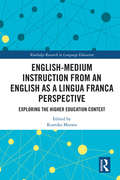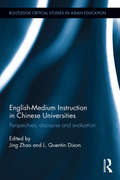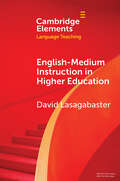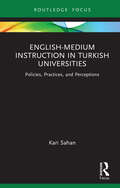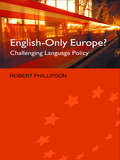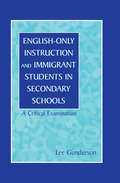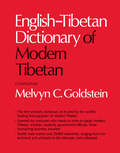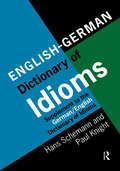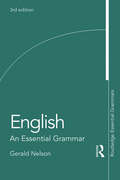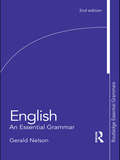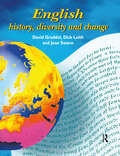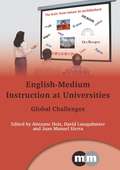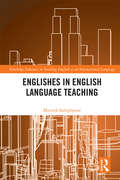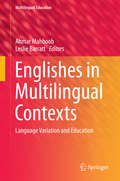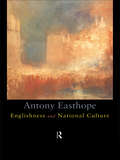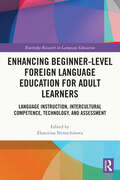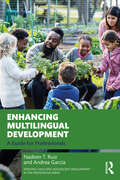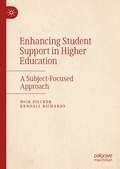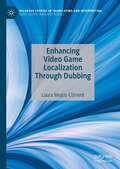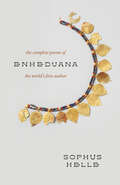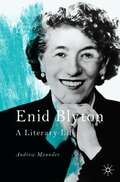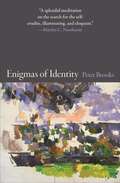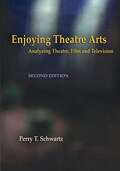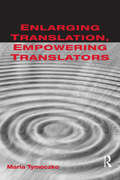- Table View
- List View
English-Medium Instruction from an English as a Lingua Franca Perspective: Exploring the Higher Education Context (Routledge Research in Language Education)
by Kumiko MurataEnglish is increasingly used as a lingua franca (ELF) in communicative situations the world over with the acceleration of globalisation. This is in line with the increased introduction of English-medium instruction (EMI) to higher education institutions in many parts of the world to further promote both students’ and faculty’s mobility to make them competitive and employable in the globalised world, and to make their institutions more attractive and reputable. EMI and ELF, however, are rarely explicitly investigated together despite the fact that the spread of EMI cannot be separated from that of ELF. This volume tackles the issue head on by focusing on EMI in higher education from an ELF perspective. The volume includes contributions by Asian, European, Middle Eastern, South American and Anglo-American scholars. It discusses language policies, attitudes and identities, analyses of classroom EMI practices, case studies and finally, pedagogical implications from an ELF perspective, incorporating also theoretical and empirical issues in conducting EMI courses/programmes. The volume will be of great interest and use, not only to those who are conducting research on ELF, EMI, CLIL, language policy and related fields, but also to classroom teachers and policy makers who are conducting and/or planning to start EMI courses/programmes in their institutions or countries all over the world.
English-Medium Instruction in Chinese Universities: Perspectives, discourse and evaluation (Routledge Critical Studies in Asian Education)
by Jing Zhao L. Quentin DixonThis edited book is about the rationale, practice and classroom implementation of English-medium instruction courses in Chinese universities. It specifically focuses on classroom discourse analysis across different disciplines and settings. The main themes of this book are: describing the state educational policies toward English-medium instruction at the tertiary level; distinguishing English-medium instruction from mainstream foreign language learning; analyzing curricula and discourse at the classroom level and evaluating the learning effectiveness of these courses. This book covers the widespread implementation of English-medium courses in China across different disciplines, and it provides a window for researchers and practitioners from other parts of the world to see the curriculum design, lesson planning, discourse features and teacher-student interaction in English-medium classrooms in China. Contributors to this volume consists of a panel of highly respected researchers in the fields of bilingual education, English-medium instruction, classroom discourse analysis and language program evaluation. Chapters include, Balance of Content and Language in English-Medium Instruction Classrooms English-Medium Instruction in a Math Classroom: An Observation Study of Classroom Discourse Asking and answering questions in EMI classrooms: What is the Cognitive and Syntactic Complexity Level?
English-Medium Instruction in Higher Education (Elements in Language Teaching)
by David LasagabasterThis Element focuses on English-Medium instruction (EMI), an educational approach that is spreading widely and rapidly in higher education institutions throughout the world because it is regarded as a lynchpin of the internationalisation process. The main aim of the Element is to provide critical insights into EMI implementation and the results obtained so far in diverse university contexts. After defining EMI and analysing the rapid extension it has experienced, the volume tackles issues such as stakeholders' views on how EMI programmes are being implemented, the impact of teaching and learning both content and language in a foreign language, translanguaging practices in English-medium lectures, and how assessment has hitherto been addressed. Each section aims to bring to light new avenues for research. The Element wraps up with a description of the many challenges ahead.
English-Medium Instruction in Turkish Universities: Policies, Practices, and Perceptions (Routledge Focus on English-Medium Instruction in Higher Education)
by Kari SahanIn response to the growing use of English as an international language, the number of English-medium instruction (EMI) programs in higher education has increased. However, decisions to implement EMI programs are often made through top-down policymaking processes with little consideration for the educational issues surrounding language policy changes.This book examines the variation with which EMI is implemented at universities in Turkey through a multilevel empirical investigation of policies, practices, and perceptions. In addition to providing a sociohistorical overview of EMI in Turkey, the book draws on a dataset that includes policy documents, classroom observations, interviews with teachers, and focus group discussions with students. Despite national policies which envision a "one-language-at-a-time" model of EMI education, this book argues that EMI is neither English-only nor English-always in practice. By highlighting the variation with which EMI is implemented at and across Turkish universities, this study illustrates the need for more comprehensive EMI policies and processes aimed at integrating content and language learning in higher education.Implications are discussed with respect to policy planning, program development, and pedagogical support and will be relevant for researchers and postgraduate research students interested in EMI, particularly in the Turkish context.
English-Only Europe?: Challenging Language Policy
by Robert PhillipsonEnglish-Only Europe? explores the role of languages in the process of European integration.Languages are central to the development of an integrated Europe. The way in which the European Union deals with multilingualism has serious implications for both individual member countries and international relations.In this book, Robert Phillipson considers whether the contemporary expansion of English represents a serious threat to other European languages. After exploring the implications of current policies, Phillipson argues the case for more active language policies to safeguard a multilingual Europe. Drawing on examples of countries with explicit language policies such as Canada and South Africa, the book sets out Phillipson's vision of an inclusive language policy for Europe, and describes how it can be attained.
English-Only Instruction and Immigrant Students in Secondary Schools: A Critical Examination
by Lee GundersonThis book is for teachers, teacher educators, school and district administrators, policy makers, and researchers who want to know about literacy, cultural diversity, and students who speak little or no English. It offers a rich picture of the incredible diversity of students who enter secondary school as immigrants—their abilities, their needs, and their aspirations. The studies reported are part of a large longitudinal study of about 25,000 immigrant students in a district in which the policy is English-only instruction. These studies:*provide multiple views of the students’ lives and their success in schools where the language of instruction differs from the languages they speak with their friends and families;*explore the students’ views of teaching and learning; *describe the potential differences between the students views and those of their teachers; *look at issues related to students’ views of their identities as they work, study, and socialize in a new environment; and*examine different reading models designed to facilitate the learning of English as a second language (ESL). Educators and researchers will find the descriptions of students’ simultaneous learning of English and of academic content relevant to their view of whether instruction should be English only or bilingual. For teachers who view multicultural education as an important endeavor, this book may on occasion surprise them and at other times confirm their views. The author does not attempt to develop a particular political viewpoint about which approach works best with immigrant students. Rather, the objective of the studies was to develop a full, rich description of the lives of immigrant high school students enrolled in classes where the medium of instruction is English. The reader is left to evaluate the results.
English-Russian Russian-English Medical Dictionary and Phrasebook
by Yuliya BaldwinFirst Published in 2012. Routledge is an imprint of Taylor & Francis, an informa company.
English-Tibetan Dictionary of Modern Tibetan
by Melvyn C. GoldsteinThe liberalization of political and intellectual life in China and the rise of Tibetan exile communities throughout the world have produced a resurgence of spoken and written Tibetan. These developments, together with increasing contacts between Western scholars and Tibetans, have created a widening circle of English-speakers—in government, business, academia, and elsewhere—who need to speak or write Tibetan with precision and clarity. For these people, and for others who want to communicate with Tibetans in their own language, Professor Goldstein's Dictionary will be an indispensable aid.The first scholarly English-Tibetan dictionary, as well as the only one that is semantically sensitive, this work specifies the Tibetan terms that correspond to the submeanings of a single English term. Containing roughly 16,000 main entries, most of which have multiple subentries, the Dictionary treats a total of 45,000 lexical items. Each entry includes both the written Tibetan orthography and a phonemic notation to indicate pronunciation. Grammatical features are also noted, and all examples of usage are presented with the romanticization of the written Tibetan and phonemic notation of the spoken forms. An introductory essay familiarizes users with the main features of Tibetan grammar.The liberalization of political and intellectual life in China and the rise of Tibetan exile communities throughout the world have produced a resurgence of spoken and written Tibetan. These developments, together with increasing contacts between Western s</DIV
English/German Dictionary of Idioms: Supplement to the German/English Dictionary of Idioms
by Professor Hans SchemannThis dictionary is the ideal supplement to the German/English Dictionary of Idioms, which together give a rich source of material for the translator from and into each language. The dictionary contains 15,000 headwords, each entry supplying the German equivalents, variants, contexts and the degree of currency/rarity of the idiomatic expression. This dictionary will be an invaluable resource for students and professional literary translators.Not for sale in Germany, Austria or Switzerland
English: An Essential Grammar (Routledge Essential Grammars #G29)
by Gerald NelsonEnglish: An Essential Grammar is written specifically for native speakers, beginning with the basics and going on to deal with phrase, clause and sentence structure, word formation and spelling. This fully revised third edition features new material on: the structure of phrases and clauses light verbs nominal adjectives the Operator preposition to and infinitival to the four thats determiners, prepositions, and common errors With new exercises and answers for all new sections, this Essential Grammar continues to be the ideal reference for anyone who would like to improve their knowledge of English grammar.
English: An Essential Grammar (Routledge Essential Grammars)
by Gerald NelsonEnglish: An Essential Grammar is a concise and user-friendly guide to the grammar of modern English, written specifically for native speakers and based on genuine samples of contemporary spoken and written English. In the first four chapters, this book covers the essentials of English grammar, beginning with the basics and going on to deal with phrase, clause and sentence structure. A fifth chapter deals with English word formation and spelling, including problem spellings and British and American spelling variants. Features include: discussion of points that often cause problems guidance on sentence building and composition practical spelling guidelines explanation of grammatical terms a set of exercises at the end of each chapter appendix of irregular verbs. With numerous language examples bringing grammar to life, this Essential Grammar will help you read, speak and write English with greater confidence. It is ideal for everyone who would like to improve their knowledge of English grammar. Gerald Nelson is Professor in the English Department at The Chinese University of Hong Kong, and formerly Reader in the Department of English Language and Literature, University College London, UK.
English: History, Diversity and Change
by Joan Swann Dick Leith David GraddolThe story of English is often presented as one of progress: from a set of Germanic dialects to a fully-fledged national and international language. The emphasis in this book is on the diversity of English throughout its history and the changing social meanings of different varieties of English.
EnglishMedium Instruction at Universities
by Aintzane Doiz David LasagabasterThis book provides critical insights into the English-medium instruction (EMI) experiences which have been implemented at a number of universities in countries such as China, Finland, Israel, the Netherlands, South Africa, Spain and the USA, which are characterised by differing political, cultural and sociolinguistic situations. In particular, it reflects on the consequences of implementing EMI as an attempt to gain visibility and as a strategy in response to the need to become competitive in both national and international markets. The pitfalls and challenges specific to each setting are analysed, and the pedagogical issues and methodological implications that arise from the implementation of these programmes are also discussed. This volume will serve to advance our awareness about the strategies and tools needed to improve EMI at tertiary level.
Englishes in English Language Teaching (Routledge Advances in Teaching English as an International Language Series #1)
by Marzieh SadeghpourThe unprecedented growth and recognition of new world Englishes, call for English language teaching programs to consider the place and relevance of the paradigm of World Englishes to the content and delivery of their curricula. This concern is particularly compelling in the multi-varietal contexts such as Australia where speakers from different Kachruvian Circles interact frequently with one another. Investigating the place and pertinence of World Englishes in English language teaching in Australia this book explores the perceptions of English language teachers from culturally and linguistically diverse backgrounds working in Australia. Looking at the effect on teachers’ confidence when dealing with different varieties of English, the pedagogical implications and the causes of varying degrees of perception among teachers. The author highlights the possible changes that could take place that would pave the ground for the development of World Englishes-informed curriculum and pedagogy for English as an International Language, which would in turn provide opportunities for learners to develop requisite competencies for intercultural communication. These are the skills which enable learners to successfully interact with speakers of various Englishes and negotiate and navigate with their interlocutors the differing cultural conceptualisations associated with the varieties of English during international and intercultural communication. Vital reading for anyone researching English language teaching or varieties of English and those teaching English as an international language anywhere in the world.
Englishes in Multilingual Contexts
by Ahmar Mahboob Leslie BarrattThe chapters in this volume allow readers to develop a broad understanding of the issues around language variation and to recognise pedagogical implications of this work in multilingual contexts The authors explore how variations in Englishes around the world relate to issues in English language teaching and learning. The English language has always existed alongside other languages. However, the last 200 years have shown a dramatic increase in the range, extent and context of contact between English and other languages. As a result of this contact, we find marked variations in Englishes around the world. The first part includes chapters of importance in studying English language variation in the context of education. The second part builds on an understanding of variation and identifies pedagogical possibilities that respect language variation and yet empower English language learners in diverse contexts.
Englishness and National Culture
by Antony EasthorpeIn this highly engaging book, Antony Easthope examines 'Englishness' as a form and a series of shared discourses. Discussing the subject of 'nation' - a growing area in literary and cultural studies - Easthope offers polemical arguments written in a lively and accessible style. Englishness and National Culture asserts a profound and unacknowledged continuity between the seventeenth century and today. It argues that contemporary journalists, historians, novelists, poets and comedians continue to speak through the voice of a long-standing empiricist tradition.
Enhancing Beginner-Level Foreign Language Education for Adult Learners: Language Instruction, Intercultural Competence, Technology, and Assessment (Routledge Research in Language Education)
by Ekaterina NemtchinovaThis book is an authoritative text that explores best classroom practices for engaging adult learners in beginner-level foreign language courses. Built around a diverse range of international research studies and conceptual articles, the book covers four key issues in teaching language to novice students: development of linguistic skills; communicative, and intercultural competence; evaluation and assessment; and the use of technology. Each chapter includes teaching insights that are supported by critical research and can be practically applied across languages to enhance instructional strategies and curriculum designs. The text also aims to build intercultural competence, harness technology, and design assessment to stimulate effective learning in formal instructional settings including colleges, universities, and specialist language schools. With its broad coverage of language pedagogy at the novice level, this book is a must read for graduate students, scholars, researchers, and practitioners in the fields of language education, second language acquisition, language teaching and learning, and applied linguistics.
Enhancing Multilingual Development: A Guide for Professionals (Applying Child and Adolescent Development in the Professions Series)
by Nadeen T. Ruiz Andrea GarcíaThis accessible volume presents an up-to-date overview of how young children, older youth, and adults develop multilingual proficiencies. Importantly, it highlights an assets view of multilingualism, offering clear recognition that multilingual competencies are both functional and highly valued in communities across the globe.Dispelling common myths, it explores the benefits of multilingualism spanning interpersonal, academic, and professional settings. With these settings in mind, the book provides practical information on how professionals can promote effective communication with colleagues and clients from a variety of language backgrounds. Each chapter comes equipped with a series of true or false statements where you can record your predictions and learn as you read. Chapters cover topics including the economic and cognitive benefits of multilingualism, social influences, the age factor, family bilingualism and optimal teaching and learning conditions. Finally, the book concludes by providing various step-by-step resources for creating optimal conditions that further develop and support multilingualism in your professional field.Containing suggestions for research-based practices in home, school, and professional settings to enhance multilingual development, this book is essential for professionals working with multilingual young children, older youth, and adults, as well as those who require a foundational understanding of multilingualism.
Enhancing Student Support in Higher Education: A Subject-Focused Approach
by Nick Pilcher Kendall RichardsThis book is about supporting students in Higher Education using language, and specifically using a combination of written text based linguistic approaches alongside and with other non-text related languages. The authors call this a beyond-text subject based approach and argue that this can more effectively help students. The book first outlines and describes a ‘paradigm of linguistics’ that sees support as being only possible through linguistics written text approaches. It then describes how the authors have found through their own research studies that such approaches do not go far enough to best support students. They offer alternatives and justify them theoretically and empirically, and also suggest ways in which others can use similar approaches to best support students in HE. This book will be of interest to practitioners, students, teachers and researchers in the fields of Applied Linguistics, TESOL, English Medium Instruction (EMI), EAP and language education policy.
Enhancing Video Game Localization Through Dubbing (Palgrave Studies in Translating and Interpreting)
by Laura Mejías-ClimentThis book addresses the hot topic in audiovisual translation (AVT) of video game localization through the unique perspective of dubbing, an area which has so far received relatively little scholarly focus. The author analyses the main characteristics of video game localization within the context of English-Spanish dubbing, and emphasizes the implications for research and localization as a professional practice. The book will appeal to translation studies scholars and students, as well as AVT professionals looking to understand localization processes from a systematized approach.
Enheduana: The Complete Poems of the World's First Author
by Sophus HelleThe complete poems of the priestess Enheduana, the world&’s first known author, newly translated from the original Sumerian Enheduana was a high priestess and royal princess who lived in Ur, in what is now southern Iraq, about 2300 BCE. Not only does Enheduana have the distinction of being the first author whose name we know, but the poems attributed to her are hymns of great power. They are a rare flash of the female voice in the often male-dominated ancient world, treating themes that are as relevant today as they were four thousand years ago: exile, social disruption, the power of storytelling, gender-bending identities, the devastation of war, and the terrifying forces of nature. This book is the first complete translation of her poems from the original Sumerian. Sophus Helle&’s translations replicate the intensity and imagery of the original hymns—literary time bombs that have lain buried for millennia. In addition to his translations, Helle provides background on the historical context in which Enheduana&’s poems were composed and circulated, the works&’ literary structure and themes, and their reception in both the ancient and the modern world. Unjustly forgotten for millennia, Enheduana&’s poems are essential reading for anyone interested in the literary history of women, religion, the environment, gender, motherhood, authorship, and empire.
Enid Blyton: A Literary Life (Literary Lives)
by Andrew MaunderThis book is a study of the best-selling writer for children Enid Blyton (1897-1968) and provides a new account of her career. It draws on Blyton’s business correspondence to give a fresh account of a misunderstood figure who for forty years was one of Britain’s most successful and powerful authors. It examines Blyton’s rise to fame in the 1920s and considers the ways in which she managed her career as a storyteller, journalist and magazine editor. There is discussion of her most famous series including the Famous Five, the Secret Seven, Malory Towers and Noddy, but attention is also given to lesser-known works including the family stories she published to acclaim in the 1940s and early 1950s, as well as her attempts to become a dramatist. The book also discusses Blyton’s fluctuating critical reputation, how she and her works were received and how Blyton the person has fared at the hands of biographers and the media.
Enigmas of Identity
by Peter BrooksFrom eminent critic Peter Brooks, an exploration of the modern preoccupation with identity"We know that it matters crucially to be able to say who we are, why we are here, and where we are going," Peter Brooks writes in Enigmas of Identity. Many of us are also uncomfortably aware that we cannot provide a convincing account of our identity to others or even ourselves. Despite or because of that failure, we keep searching for identity, making it up, trying to authenticate it, and inventing excuses for our unpersuasive stories about it. This wide-ranging book draws on literature, law, and psychoanalysis to examine important aspects of the emergence of identity as a peculiarly modern preoccupation.In particular, the book addresses the social, legal, and personal anxieties provoked by the rise of individualism and selfhood in modern culture. Paying special attention to Rousseau, Freud, and Proust, Brooks also looks at the intersection of individual life stories with the law, and considers the creation of an introspective project that culminates in psychoanalysis.Elegant and provocative, Enigmas of Identity offers new insights into the questions and clues about who we think we are.
Enjoying Theatre Arts: Analyzing Theatre, Film and Television
by Perry T. SchwartzEnjoying Theatre Arts uses examples from Theatre, Film and Television to develop the unique analysis system detailed in this book. The text is designed as an introduction for students of the theatre arts as well as the general audience member. Contents Part One - The Theory And Analysis Art in Theatre Arts Aristotle's Six Elements of Drama Genre Based Narrative Structure Analysis Part Two - The Artistic Side Criticism The Writer The Director The Actor The Designers Part Three - The Business Side The Producer Film, Theatre, Television Business Structure The Artist/Craftsman and the Business.
Enlarging Translation, Empowering Translators
by Maria TymoczkoBeginning with the paradox that characterizes the history of translation studies in the last half century - that more and more parameters of translation have been defined, but less and less closure achieved - the first half of Enlarging Translation, Empowering Translators calls for radical inclusionary approaches to translation, including a greater internationalization of the field. The book investigates the implications of the expanding but open definition of translation, with a chapter on research methods charting future approaches to translation studies. In the second half of the book, these enlarged views of translation are linked to the empowerment and agency of the translator. Revamped ideological frameworks for translation, new paradigms for the translation of culture, and new ways of incorporating contemporary views of meaning into translation follow from the expanded conceptualization of translation, and they serve as a platform for empowering translators and promoting activist translation practices. Addressed to translation theorists, teachers, and practising translators alike, this latest contribution from one of the leading theorists in the field sets new directions for translation studies.
